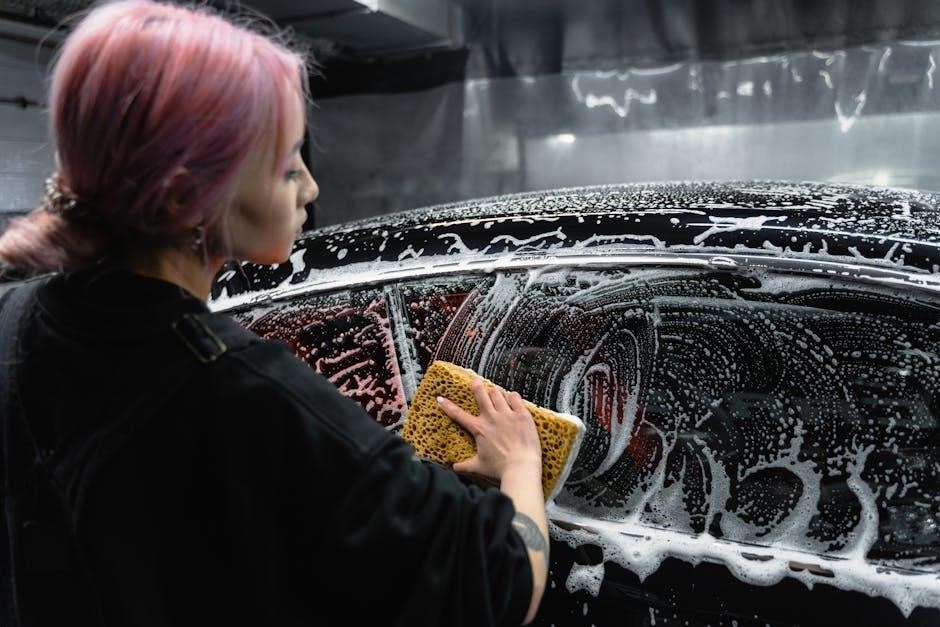This manual provides essential guidance for maintaining Manitowoc ice machines, ensuring optimal performance, hygiene, and longevity․ It outlines step-by-step cleaning processes, safety protocols, and best practices for effective maintenance․
Overview of Manitowoc Ice Machines
Manitowoc ice machines are renowned for their durability, efficiency, and versatility, catering to various commercial needs․ Available in models like S-Series, Indigo, and NEO, they offer modular and under-counter designs, ideal for restaurants, hotels, and healthcare facilities․ These machines are designed to produce high-quality ice consistently, with features like advanced cooling systems and smart diagnostics․
Key components include the evaporator, condenser, and water filtration systems, ensuring clean and reliable ice production․ Manitowoc machines are also energy-efficient, reducing operational costs․ Regular maintenance is crucial to uphold performance, making this manual an essential resource for users seeking to optimize their equipment’s longevity and functionality․
Importance of Regular Cleaning and Maintenance
Regular cleaning and maintenance are vital for ensuring Manitowoc ice machines operate efficiently and produce clean, high-quality ice․ Neglecting maintenance can lead to mold, bacteria growth, and mineral buildup, compromising ice quality and safety․ Proper upkeep also prevents mechanical issues, reduces energy consumption, and extends the machine’s lifespan․ Cleaning must be done with approved Manitowoc cleaners to avoid damaging components, ensuring compliance with health standards․ Consistent maintenance routines help identify and address potential problems early, preventing unexpected breakdowns and downtime․ By prioritizing regular care, users can uphold hygiene, performance, and reliability, making it essential for businesses that rely on consistent ice production․
Key Components of the Manitowoc Ice Machine
The Manitowoc ice machine consists of several critical components that work together to produce ice efficiently․ The evaporator is where water freezes into ice, while the condenser dissipates heat to maintain proper refrigeration․ The compressor drives the refrigeration cycle, ensuring the system operates smoothly․ Additionally, the water pump supplies water to the evaporator, and the control board manages the machine’s operations, including startup, ice production, and shutdown․ Understanding these components is essential for effective cleaning and maintenance, as each part plays a vital role in ice production and overall machine functionality․

Preparation for Cleaning
Begin by turning off the ice machine and allowing it to cool․ Gather approved cleaning agents, gloves, and tools; Ensure all safety precautions are followed before starting․
Safety Precautions Before Cleaning
Always turn off the ice machine and unplug it before cleaning to avoid electrical hazards․ Allow the machine to cool down to prevent burns from hot components; Wear protective gloves and eyewear to protect against cleaning agents and sharp edges․ Ensure the area around the machine is clear of clutter to prevent tripping․ Never use abrasive materials or unauthorized cleaners, as they may damage the machine or leave harmful residues․ Avoid wearing loose clothing or jewelry that could get caught in moving parts․ If unsure about any step, consult the official Manitowoc manual or contact a professional technician․ Following these precautions ensures a safe and effective cleaning process․
Gathering Necessary Cleaning Supplies
To clean your Manitowoc ice machine effectively, gather essential supplies․ Use Manitowoc-approved ice machine cleaner and sanitizer to ensure compatibility and safety․ A soft-bristle brush or non-abrasive scrubber is ideal for removing stubborn buildup without damaging surfaces․ Microfiber cloths are recommended for wiping down exterior and interior components․ A descaling solution may be required if mineral buildup is present․ Additionally, wear protective gloves and goggles to safeguard against harsh chemicals․ Have a bucket or container for water and cleaning solutions․ Ensure all supplies are within reach to streamline the cleaning process․ Avoid using unauthorized cleaners or abrasive materials, as they may harm the machine or leave residues․ Properly gathering these supplies ensures a safe and efficient cleaning routine․
Disconnecting the Ice Machine from Power
Before cleaning, always disconnect the Manitowoc ice machine from its power source to ensure safety and prevent electrical hazards․ Locate the power switch, typically found on the machine or nearby, and turn it off․ Unplug the machine from the electrical outlet to completely eliminate power supply․ Verify that all lights, displays, and functions are inactive to confirm the machine is powered down․ Allow the machine to cool down for a few minutes to avoid injury from hot components․ Never attempt cleaning while the machine is operational or connected to power․ Secure the plug to prevent accidental reconnection during the cleaning process․ This step is critical for safeguarding both the technician and the equipment, ensuring a safe and effective maintenance routine․
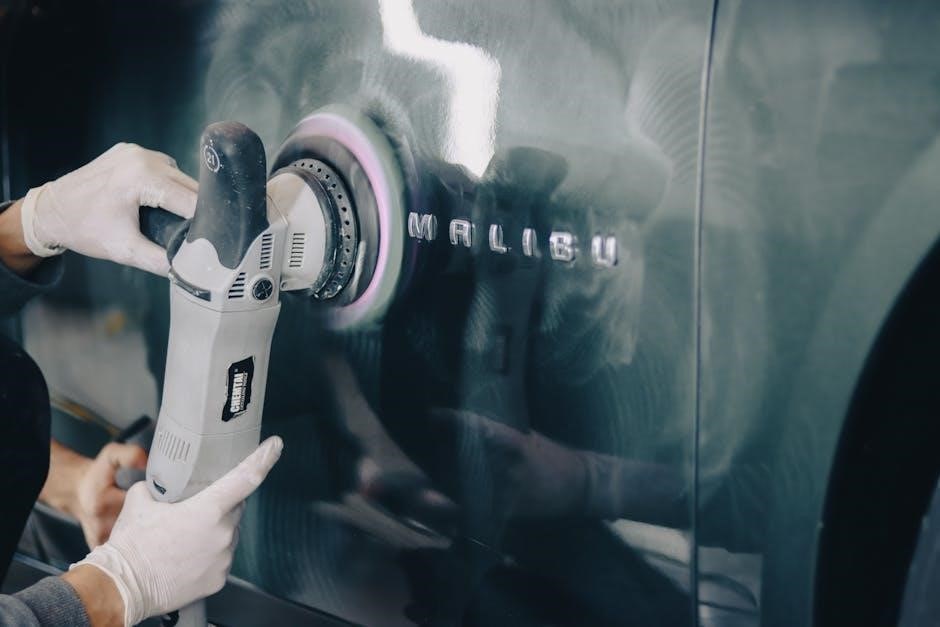
Step-by-Step Cleaning Process
This section outlines the detailed steps for cleaning Manitowoc ice machines, including removing ice, preparing the machine, and sanitizing components for optimal hygiene and performance․
Removing Ice and Preparing the Machine
Begin by removing all ice from the bin or dispenser and discarding it․ This ensures a clean slate for sanitizing and prevents contamination․ Next, initiate the cleaning and sanitizing sequence on the ice machine, as outlined in the manual․ This step is crucial for preparing the machine for deep cleaning․ Ensure the machine is powered off and unplugged before starting any manual cleaning processes․ Remove any removable parts, such as ice scoops or bins, and wash them separately with approved cleaners․ This preparation phase ensures all components are accessible for thorough cleaning and sanitization, maintaining hygiene and performance standards․ Always follow the manufacturer’s instructions for specific models like the S-Series, Indigo Series, or NEO Series․
Cleaning the Exterior and Interior Surfaces
Start by wiping down the exterior with a soft, clean cloth and a mild detergent solution to remove dirt and grime․ Avoid using abrasive materials that could scratch the surface․ For the interior, focus on areas like the ice bin, dispensers, and evaporator plates․ Use a Manitowoc-approved cleaning agent to ensure compatibility and effectiveness․ Scrub all surfaces thoroughly, paying attention to corners and crevices where debris may accumulate․ Rinse all cleaned parts with clean water to remove any residual cleaner․ After cleaning, dry the surfaces with a clean towel to prevent water spots and mineral deposits․ Regular cleaning of both exterior and interior surfaces helps maintain hygiene and prevents bacterial growth, ensuring the machine produces clean, fresh ice consistently․
Sanitizing the Ice Machine Components
Sanitizing is a critical step to ensure the ice machine produces clean and safe ice․ Use Manitowoc-approved sanitizing solutions to avoid damaging components․ Start by mixing the sanitizer according to the manufacturer’s instructions․ Apply the solution to all surfaces, including the ice bin, dispensers, and evaporator plates․ Let it sit for the recommended time to effectively kill bacteria and mold․ Rinse thoroughly with clean water to remove any chemical residue․ Pay special attention to areas prone to moisture accumulation, as these are common breeding grounds for contaminants․ Regular sanitizing helps prevent the growth of harmful microorganisms, ensuring the ice produced is safe for consumption․ Always follow the manual’s guidelines to maintain hygiene and comply with health regulations․
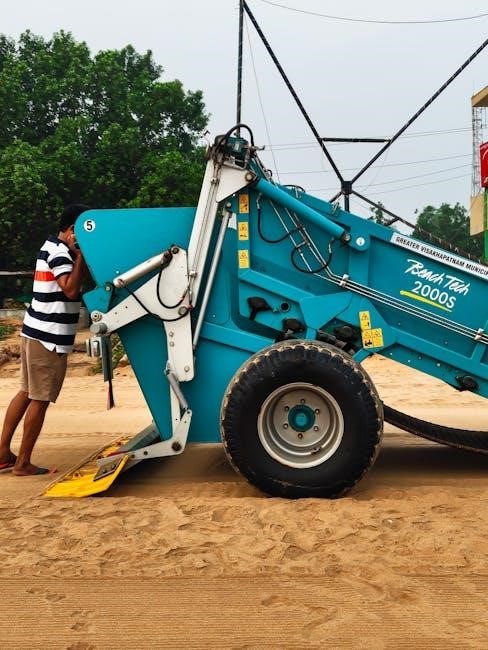
Advanced Cleaning Techniques
Advanced cleaning involves deep sanitizing, descaling, and thorough component inspection․ Use approved sanitizers and follow manual guidelines to ensure optimal performance and hygiene in Manitowoc ice machines․
Deep Cleaning the Condenser Coils
Deep cleaning the condenser coils is crucial for maintaining efficient ice machine operation․ Use a soft-bristle brush or compressed air to remove dust and debris․ For stubborn dirt, gently wash with mild detergent and rinse thoroughly․ Ensure coils are dry before restarting the machine․ Regular cleaning prevents overheating and extends equipment life․ Always refer to the Manitowoc manual for specific guidelines, as improper cleaning can damage components or void warranties․ Proper maintenance ensures optimal performance, energy efficiency, and consistent ice production․ Keep the area around the condenser coils clear to enhance airflow and reduce the risk of contamination․ Regular inspections and cleaning schedules should be logged for future reference and compliance with health standards․
Cleaning the Water Filter and Distribution System
Cleaning the water filter and distribution system is essential for ensuring clean ice production․ Start by shutting off the water supply and disconnecting the filter․ Remove and soak the filter in a Manitowoc-approved cleaning solution․ Scrub gently to remove mineral deposits and scale buildup․ Rinse thoroughly and sanitize using an Manitowoc-recommended sanitizer․ Reinstall the filter and flush the system to remove any cleaning residue․ Regularly cleaning the water filter prevents contamination and maintains water quality․ Inspect the distribution system for blockages or mineral buildup and clean as needed․ Use only Manitowoc-approved cleaning agents to avoid damaging components․ Proper maintenance ensures consistent ice quality and prevents costly repairs․ Always refer to the manual for specific cleaning intervals and guidelines to maintain optimal performance and hygiene standards․
Sanitizing the Ice Bin and Dispenser
Sanitizing the ice bin and dispenser is crucial for maintaining hygiene and preventing contamination․ Start by removing all ice and washing the bin with a mild detergent․ Rinse thoroughly and sanitize using a Manitowoc-approved sanitizer solution․ Allow the solution to contact all surfaces for the recommended time before rinsing․ For the dispenser, wipe down surfaces with a sanitizing agent and ensure all areas are clean and dry․ Regular sanitizing prevents mold, mildew, and bacterial growth․ Perform this process every 1-2 months, or as needed, to ensure clean and safe ice production․ Always use Manitowoc-recommended cleaning agents to avoid damaging components and to maintain compliance with health standards․ Proper sanitization ensures the ice machine produces high-quality, safe ice consistently․
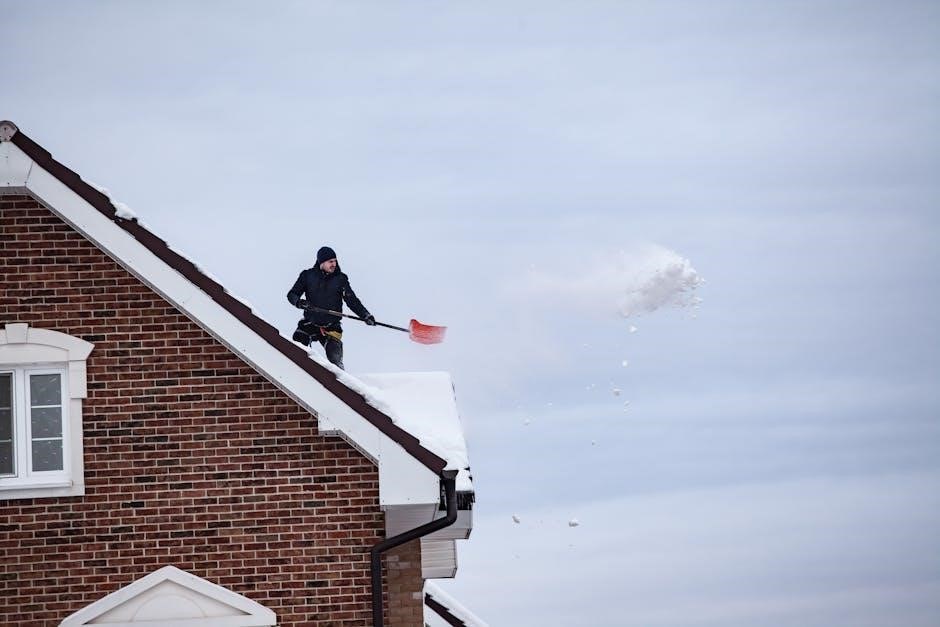
Post-Cleaning Procedures
After cleaning, ensure all components are dry and free from contaminants․ Reassemble the machine, plug it back in, and run a test cycle to confirm proper function․
Drying the Machine After Cleaning
Drying the Manitowoc ice machine after cleaning is crucial to prevent moisture buildup, which can lead to mold, mildew, or bacterial growth․ Use clean, lint-free towels to pat dry all surfaces, paying extra attention to crevices and internal components․ Allow the machine to air dry for at least 30 minutes before plugging it back in․ Ensure the ice bin and dispenser are completely dry to avoid water spots or contamination․ For thorough drying, you can use a clean, dry cloth to wipe down every part․ Proper drying ensures the machine operates efficiently and maintains hygiene standards for safe ice production․
Inspecting for Any Remaining Contaminants
After cleaning and drying, inspect the Manitowoc ice machine thoroughly to ensure no contaminants remain․ Visually examine all surfaces, paying attention to corners, seals, and internal components․ Check for any residue, mineral deposits, or mold growth․ Use a clean, dry cloth to wipe down areas that may have been missed during cleaning․ Test the machine by producing a small batch of ice to ensure no off-tastes or odors persist․ Inspect the ice bin and dispenser for cleanliness and proper function․ If any contaminants are found, repeat the cleaning process as needed․ Proper inspection ensures the machine is safe and ready for use, maintaining high standards of hygiene and performance․
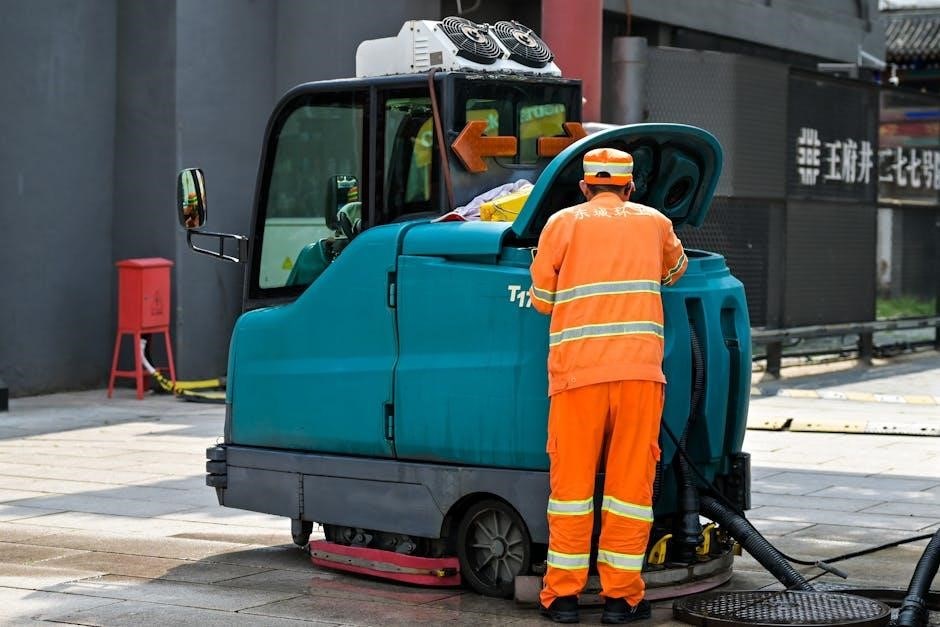
Reassembling and Testing the Machine
After cleaning and drying, carefully reassemble the Manitowoc ice machine by following the manufacturer’s instructions․ Ensure all components, including the water filter, distribution system, and electrical connections, are securely reattached․ Once reassembled, perform a test run to verify proper function․ Check for any leaks, unusual noises, or issues with ice production․ Allow the machine to run through a full cycle to ensure it is operating smoothly․ Test the water flow, ice formation, and dispensing mechanisms․ If everything functions correctly, the machine is ready for use․ If issues persist, consult the manual or contact a professional for assistance․ Proper reassembly and testing are critical to maintaining efficiency and safety․

Regular Maintenance Schedule
Regular maintenance ensures optimal performance and longevity․ Schedule cleaning every 3-6 months, depending on usage․ Monitor ice production, water quality, and condenser efficiency monthly․ Log all activities for reference․
Recommended Cleaning Frequency
Regular cleaning is crucial for maintaining Manitowoc ice machines’ efficiency and hygiene․ It is recommended to clean the machine every 3 to 6 months, depending on usage and water quality․ High-usage environments may require more frequent cleaning to prevent scale buildup and bacterial growth․ Neglecting this schedule can lead to reduced ice production, poor ice quality, and potential health risks․ Additionally, the condenser coils and water filters should be inspected and cleaned every 1 to 2 months to ensure optimal performance․ Always refer to the manufacturer’s guidelines for specific recommendations tailored to your machine model and operating conditions․ Consistency in maintenance will extend the lifespan of your Manitowoc ice machine and ensure it continues to produce clean, safe ice․

Monitoring Machine Performance
Regularly monitoring your Manitowoc ice machine’s performance is essential to ensure it operates efficiently and produces high-quality ice․ Check the machine’s ice production rate, as a decrease may indicate issues like scale buildup or clogged water filters․ Listen for unusual noises, such as rattling or grinding sounds, which could signal worn or misaligned parts․ Additionally, inspect the machine for leaks or excessive condensation, as these can lead to mold growth or electrical hazards․ Ensure the machine maintains proper temperatures, as deviations may affect ice quality or indicate a malfunction․ By staying vigilant and addressing issues promptly, you can prevent breakdowns and extend the machine’s lifespan․ Always refer to the owner’s manual for specific performance benchmarks and guidelines tailored to your model․
Logging Maintenance and Cleaning Activities
Keeping a detailed log of maintenance and cleaning activities is crucial for ensuring your Manitowoc ice machine operates efficiently and safely․ Record the date, type of maintenance performed, and any issues addressed during cleaning․ This log helps track the machine’s performance over time and identifies recurring problems․ Note the cleaning agents used and their effectiveness in removing scale buildup or sanitizing surfaces․ Additionally, document any parts replaced or repaired, as this information is vital for future troubleshooting․ Regular logging also aids in compliance with health regulations and provides a clear record of accountability․ By maintaining an accurate and up-to-date log, you can ensure consistent maintenance and extend the lifespan of your ice machine․ This practice is essential for proactive management and preventing unexpected breakdowns․

Troubleshooting Common Issues
Identify common issues like reduced ice production or unusual noises․ Check for blockages, loose connections, or improper cleaning․ Address leaks promptly and verify drain functionality for optimal performance․
Identifying Common Problems After Cleaning
After cleaning, common issues may arise, such as residual contaminants or improper reassembly․ Check for visible debris or scale buildup in critical areas like the water filter or ice bin․ Unusual odors or slimy residue indicate incomplete sanitization․ Ensure all components are securely reattached to avoid leaks or mechanical failures․ Verify the ice machine’s drain system is functioning correctly to prevent water accumulation․ If ice production slows or ceases, inspect for blockages in the distribution system․ Addressing these issues promptly ensures optimal performance and hygiene․ Always refer to the manual for specific troubleshooting steps and guidelines to resolve post-cleaning problems effectively․
Resolving Issues Related to Ice Production
If the ice machine fails to produce ice after cleaning, check the water supply for proper flow and pressure․ Ensure the water filter is clean and free from blockages․ Inspect the evaporator plate for mineral buildup, as scale deposits can hinder ice formation․ Verify that the machine is properly reassembled and all electrical connections are secure․ Run a diagnostic cycle to identify any system errors․ If issues persist, consult the manual for specific troubleshooting steps or contact a certified technician․ Regular maintenance and prompt issue resolution are crucial to restoring optimal ice production and ensuring the machine operates efficiently․
Addressing Sanitization and Odor Concerns
After cleaning, sanitizing is crucial to eliminate bacteria and odors․ Use Manitowoc-approved sanitizers to ensure effectiveness and safety․ Pay attention to areas like the water reservoir, evaporator, and ice bin, as these are prone to microbial growth․ If odors persist, deep clean the condenser coils and water distribution system, as scale buildup can harbor bacteria․ Regularly replacing the water filter and descaling the machine can prevent mineral deposits that contribute to odors․ Always rinse thoroughly after sanitizing to remove any chemical residue․ A well-sanitized machine not only produces clean ice but also maintains a fresh smell, ensuring customer satisfaction and compliance with health standards․

Additional Tips and Considerations
Use Manitowoc-approved cleaners to prevent damage․ Regularly inspect and replace worn parts․ Keep the machine’s surroundings clean to avoid contamination․ Log all maintenance activities for tracking․
Using Approved Cleaning Agents
Using Manitowoc-approved cleaning agents ensures safety and effectiveness․ These products are specifically designed for Manitowoc ice machines, preventing damage to components and maintaining hygiene standards․
Non-approved cleaners may contain harsh chemicals that can harm the machine or leave residues, affecting ice quality and safety․ Always refer to the manual for recommended agents․
For optimal results, follow the dilution instructions provided with the cleaning agents․ Avoid using homemade solutions, as they may not meet sanitization requirements․
Regularly inspect the machine for mineral buildup or scale, and use Manitowoc-approved descalers if necessary․ Proper cleaning agents help extend the machine’s lifespan and ensure consistent performance․
Remember, compliance with health regulations depends on using the correct cleaning products․ Keep records of cleaning activities for future reference and maintenance tracking․
Preventing Scale Buildup and Mineral Deposits
Scale buildup and mineral deposits are common issues in ice machines, particularly when using hard water․ To prevent this, install a Manitowoc-approved water filter to reduce mineral content․ Regularly clean and descale the machine using Manitowoc-recommended descalers, following the manual’s instructions․ Monitor the machine’s performance for signs of scaling, such as reduced ice production or poor ice quality․ Maintain a routine cleaning schedule to prevent mineral accumulation․ Ensure the water supply has low mineral content, possibly using distilled water or a reverse osmosis system․ By following these steps, you can extend the machine’s lifespan and maintain optimal performance․
Ensuring Compliance with Health Regulations
Ensuring compliance with health regulations is critical for maintaining a safe and hygienic ice machine operation․ Regular cleaning and sanitizing are essential to prevent contamination and bacterial growth․ Always use Manitowoc-approved cleaning agents and follow the manufacturer’s guidelines for sanitizing․ Check local health codes to ensure your cleaning schedule meets regulatory requirements․ Properly trained staff should handle all cleaning and maintenance tasks to avoid cross-contamination․ Regular inspections by health officials should be anticipated, so keep detailed records of cleaning and maintenance activities․ Adhering to these practices ensures compliance with health standards, protecting both users and the machine’s efficiency․ By following these guidelines, you can maintain a clean, safe, and compliant ice machine environment․
Proper cleaning and maintenance are vital for optimal performance, hygiene, and longevity․ Follow guidelines to ensure compliance with health regulations and maintain reliable ice production․
Regularly cleaning and maintaining your Manitowoc ice machine ensures efficiency, hygiene, and longevity; Always disconnect power before cleaning and use approved cleaning agents to prevent damage․ Sanitize all components, including the ice bin and dispenser, to maintain health standards․ Deep clean condenser coils and water filters to optimize performance․ Schedule maintenance activities and log them for future reference․ Address issues promptly, such as scale buildup or odors, to prevent operational problems․ By following these best practices, you ensure consistent ice production and compliance with health regulations․
Final Checks for Optimal Ice Machine Performance
After completing the cleaning and maintenance process, ensure all components are reassembled correctly and the machine is reconnected to power․ Conduct a final inspection to verify proper function and ice production․ Check for leaks, unusual noises, or operational irregularities․ Ensure the ice bin is clean, dry, and free from contaminants․ Monitor the machine’s performance over the next few cycles to confirm consistent ice quality and output․ Regularly review maintenance logs to ensure compliance with health and safety standards․ Address any lingering issues promptly to maintain optimal performance and extend the machine’s lifespan;
Resources for Further Assistance
For additional support, refer to Manitowoc’s official website, which offers detailed manuals, troubleshooting guides, and contact information for customer service․ Online forums and communities, such as Reddit or specialized HVAC forums, provide peer-to-peer advice and solutions․ Authorized Manitowoc service providers can offer professional assistance for complex issues․ YouTube tutorials and manufacturer-approved cleaning guides are also valuable resources for visual learners․ Ensure to consult only trusted sources to maintain compliance with Manitowoc’s standards and safety protocols․ Regularly updating your knowledge with the latest manuals and guidelines will help maintain your ice machine’s efficiency and longevity․
